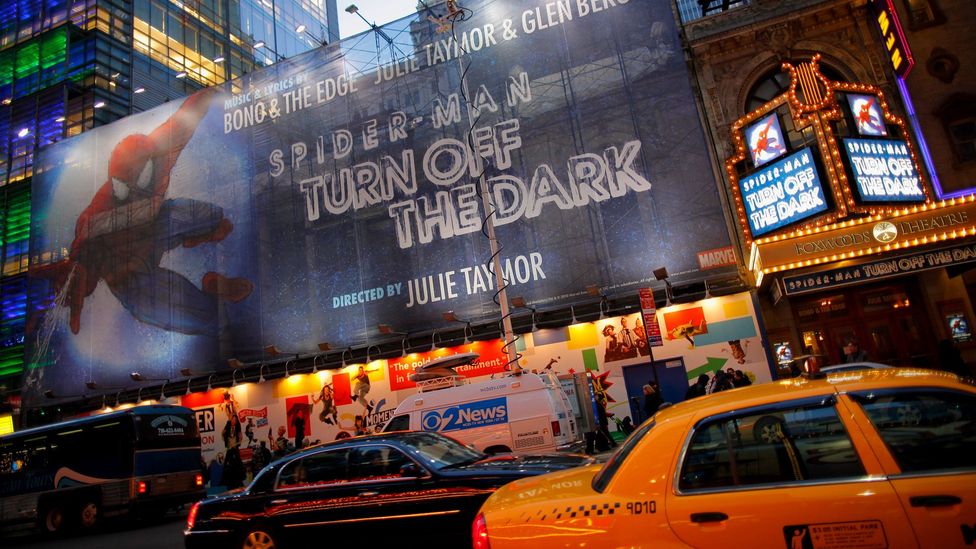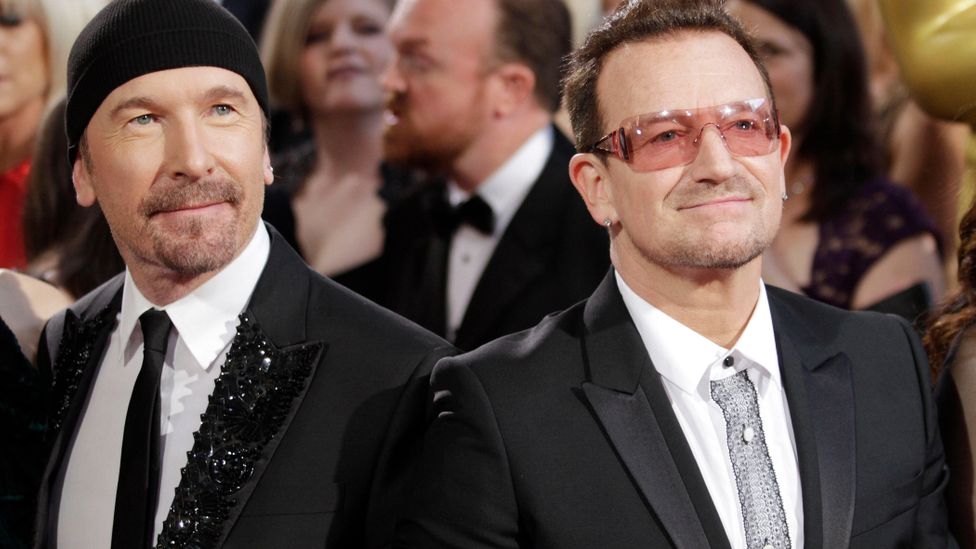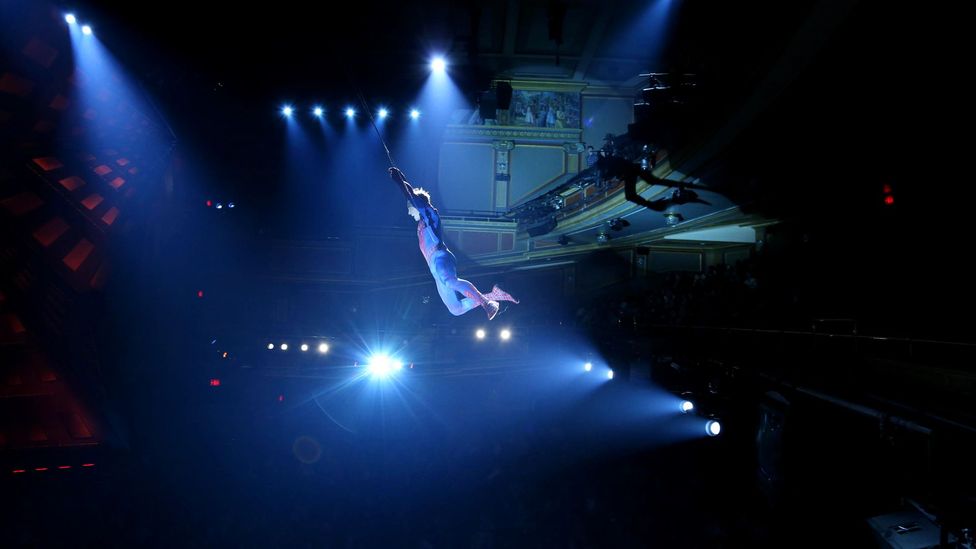Ten years ago, the show Spider-Man: Turn Off the Dark had an ill-fated first preview on Broadway – the beginning of its journey to becoming a legendary debacle, writes Nicholas Barber.
I
It’s been 10 years since one of the most momentous nights of Glen Berger’s life. He was already an established off-Broadway playwright and children’s television writer, but on 28 November 2010, a musical he had scripted had its first preview at the Foxwoods Theatre in New York – and it was shaping up to be an international smash.
More like this:
– The play that predicted the Trump era
– Why we no longer need superheroes
– Defending cinema’s biggest flop
The musical was Spider-Man: Turn Off the Dark. Its friendly neighbourhood title character had been a beloved pop-cultural icon for five decades, and had just featured in three Hollywood blockbusters. The songs were written by rock’n’roll royalty, U2’s Bono and The Edge. And the director was Julie Taymor, who had masterminded the record-breaking stage adaptation of Disney’s The Lion King. Turn Off the Dark couldn’t go far wrong with a pedigree like that. Could it?

When it closed in January 2014, it had made a loss of $60 million – a Broadway record (Credit: Getty Images)
Which is not to say that Berger wasn’t nervous. Speaking to BBC Culture from his home in upstate New York, he remembers how strange it felt to be unveiling something he and his collaborators had been devising together for years. “We were opening the door,” he says, “either to Willy Wonka’s chocolate factory or some sort of slaughterhouse.” The show relied on complicated aerial stunts in which the performers were suspended from wires, and so the first preview was bound to keep stopping and starting as technical hitches were addressed.
But everything was going relatively smoothly until the last seconds before the interval. “Then there was a flourish,” says Berger, “when Spider-Man flies off through the audience towards the balcony. And for some reason he stopped, so you had Spider-Man dangling seven feet above the first two rows. It was the worst possible position because no one could reach him. One of the crew members fetched a stick to prod him with, but that didn’t help. It was like a live Spider-Man pinata. But we knew by the end of the night, well, that’s the worst it’s ever going to be. We’ll keep improving it and improving it, and it’s going to be duck soup by the time we open in January.”
It didn’t work out like that. Before the first preview, Turn Off the Dark was already being gossiped about as a ‘troubled’ enterprise. Its initial lead producer and guiding light, Tony Adams, had had a fatal stroke in 2005 while in a meeting with The Edge. And the financial crisis of 2007 and 2008 had scared off private investors, so that in August 2009, the production found itself $20 million short of cash. But the bad luck didn’t end there. In the months that followed the first preview, the official opening was repeatedly postponed while Berger and his colleagues dealt with bruising, embargo-defying reviews, sackings, injuries, and countless technical snags.
By May 2011, Turn Off the Dark had become so synonymous with theatrical disaster that a headline in The Onion, the satirical newspaper, appeared to be only slightly exaggerating: “Nuclear Bomb Detonates During Rehearsal for ‘Spider-Man’ Musical”. The show did finally have its opening night in June 2011, but by then its fate had effectively been sealed: and though its run continued for another two-and-a-half years, when it closed in January 2014 it had made a loss of $60 million – a Broadway record. A sure-fire hit had become a legendary debacle. “I’m philosophical about all of it,” says Berger. “It might end up in my obituary, and I’m not too happy about that. But I’d rather have Spider-Man on my resume than the Iraq War.”
A written post-mortem
Berger went on to write a candid memoir, Song of Spider-Man, which grips like a murder mystery novel: as you read it, you scan the pages for clues that might account for the bloodbath. There are several right at the start of the story. The musical was announced in the summer of 2002 to capitalise on the success of Sam Raimi’s first Spider-Man film. Bono and The Edge signed up soon afterwards, but when the producers approached Taymor, she replied that she would take the job only if she “could find a narrative something to spark her imagination”.
That something was the Greek myth of Arachne, a woman who beat Athena in a weaving contest, and was transformed into a spider by the jealous goddess. Avi Arad, Marvel’s chief creative officer, objected: Arachne had nothing to do with Spider-Man, and her inclusion as a major character would be “entirely wrong”. Taymor stood her ground. So what if her concepts were gloomier, more sexualised, and, yes, more pretentious than Stan Lee and Steve Ditko’s comics or Raimi’s films? Her greatest triumphs came from her refusal to compromise. “If Arachne’s out,” she said, “then I’m out.”

U2’s Bono and The Edge wrote the songs, which were described as “like a persistent headache” by the New York Times (Credit: Alamy)
Another passage in Song of Spider-Man that might get your spider-sense tingling comes a few pages later. Bono and The Edge were so unfamiliar with Broadway musicals, apparently, that a producer had to burn them an educational four-CD compilation of “60 songs from the last sixty years of musical theatre”. The stadium rockers would “eventually dismiss nearly all the songs as mawkish, dopey, or just ‘pants'”- which could be why the songs they wrote for Turn Off the Dark sounded less like catchy show tunes than vaguely angst-ridden, minor-key U2 B-sides. Berger, who was brought in to co-write the book with Taymor in 2005, is quick to defend his comrades: “Every artist has to figure out what they’re responding to and take it from there.” But still… if you’re staging a Spider-Man musical, it’s probably not ideal to have a director who isn’t keen on Spider-Man comics and two composers who aren’t keen on musicals.
And then there was the technology that led to the pinata situation, and which drew the team’s attention away from what Berger describes as “some massive holes in the script”. The comics’ signature sequences of web-spinning and wall-crawling were recreated using computer-controlled cables and winches, but developing the machinery was a long, laborious process, and the results were only marginally less dangerous than an arm-wrestling bout with Doctor Octopus.
While swinging from wires in rehearsals, one performer broke his toe and another broke both his wrists. During the first preview, a carabiner was hurriedly unclipped from a cable and dropped on the head of Natalie Mendoza, the actress playing Arachne, leaving her concussed. Saturday Night Live responded on 12 February 2011 with a sketch about a law firm that specialised in Spider-Man-related workplace injuries. The front cover cartoon of The New Yorker on 17 January 2011 depicted a hospital ward full of battered and bandaged Spider-Men. This wasn’t the kind of publicity the producers had been hoping for.
As if the broken bones weren’t demoralising enough, the technology was eye-wateringly expensive. One million-dollar gadget was built to lower a web over the audience for the grand finale, only to be scrapped when the effect didn’t come off. Meanwhile, the largest theatre on Broadway was being refurbished to fit in all of the notoriously unreliable hardware. When the show was eventually up and running, operating costs would be $1.1 million a week. Just to break even, it would have had to sell out every performance for four years. And, on the basis of the reviews, that never seemed likely.
The critical drubbing
Although the producers kept delaying the press night, as they battled to make the plot clearer and the stunts safer, impatient critics simply bought their tickets and sharpened their knives. Hadley Freeman in the Guardian called the show “baffling in its ineptitude”. The aerobatics were “no more spectacular than any cut-price circus”, and the music was “deadening in its mediocrity, tuneless and forgettable”. Ben Brantley in the New York Times agreed that the songs “blur into a sustained electronic twang of varying volume… like a persistent headache”. Charles McNulty in the Los Angeles Times condemned Berger and Taylor’s book as “an absolute farrago”. His summary: “Incoherence isn’t much fun to sit through”.

The show’s aerial antics were plagued by technical hitches and accidents (Credit: Getty Images)
When these reviews were printed in February 2011, Berger was feeling a bit like a live Spider-Man pinata himself. His once close-knit band of collaborators was fragmenting into those who still believed in Taymor’s mystical take on the material, and those who suspected that she was suffering from the “artistic form of megalomania” mentioned in McNulty’s review. “As a writer I was fascinated by watching this little group disintegrate from lack of trust and lack of conviction,” says Berger. “What the reviews did was turn up the dial on the heat lamps. More and more I had this image of an experiment on what stress does to rats in a cage.”
In March 2011, Taymor was replaced by the more pragmatic director Philip William McKinley. A new choreographer was hired, and Berger himself had to share his credit with another writer, Roberto Aguirre-Sacasa. When the revamped version finally opened, seven months after the first preview, its mood had been lightened, its structure had been streamlined, and Arachne’s role had been reduced. Turn Off the Dark had turned off its darkness. The reviews were kinder, and the show ran until January 2014. But it never recouped its money, or repaired its reputation. At the very moment that Marvel’s superhero films were conquering global cinema, the first Marvel superhero musical was crashing down to earth. The myth of Arachne, a proud artist who was laid low by hubris, was all too apt.
The show’s fraught behind-the-scenes story came to seem like an archetypal narrative to Berger, too. “It was only after the dust had settled that I realised that the arc of it really fit with the themes that I had been writing about in my fiction for years. It really fascinates me when grandiose ideas fall short. I find that really endearing: to have this vision and then to do battle against reality, to try to bring this intangible thing into the tangible world. It’s just such a lovely thing that makes humans human. To put it in the most pollyannaish way, it was truly a gift to have gone through every moment of it. When you’re a young writer, you think, oh, I should be working on an oil rig, I should be getting real-life experiences so I can write about them later. Well, this was such a hefty experience that I can draw on it for years to come.”
If you would like to comment on this story or anything else you have seen on BBC Culture, head over to our Facebook page or message us on Twitter.
And if you liked this story, sign up for the weekly bbc.com features newsletter, called The Essential List. A handpicked selection of stories from BBC Future, Culture, Worklife and Travel, delivered to your inbox every Friday.


